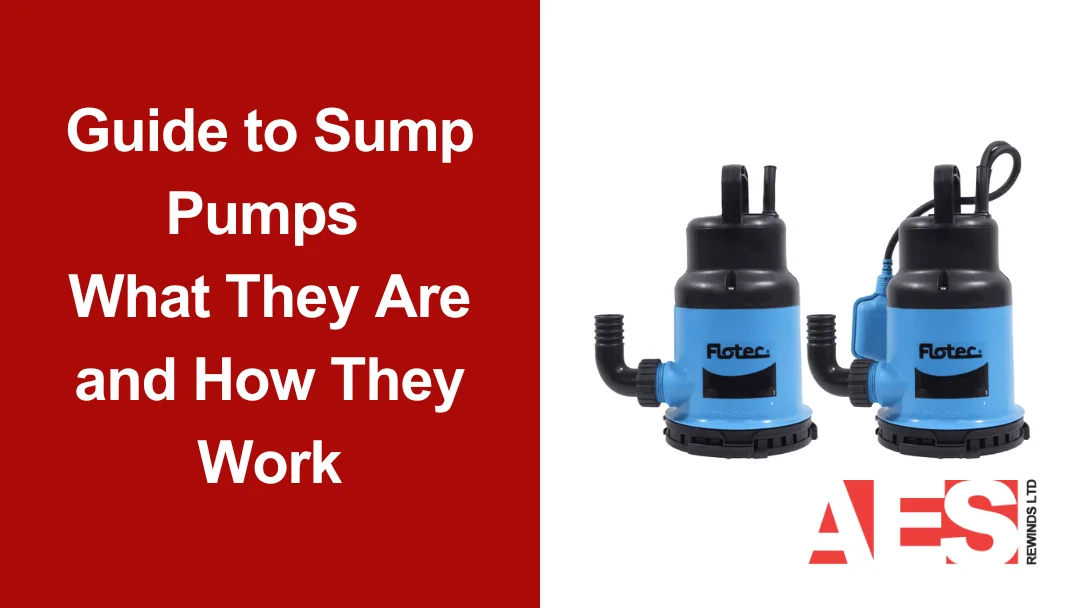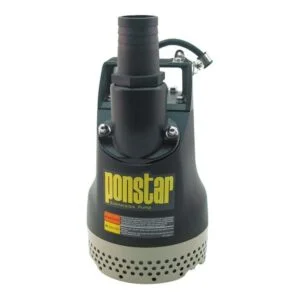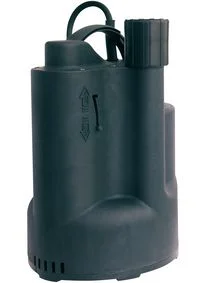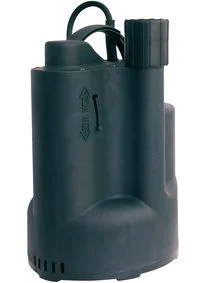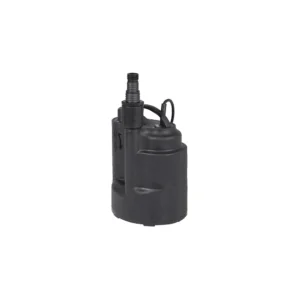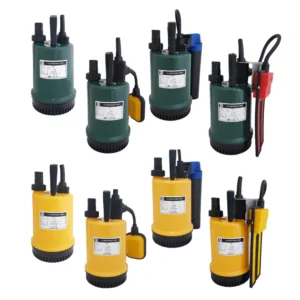As you walk into your basement, you notice a strange device humming away in the corner – a sump pump. But what is it, and how does it work its magic to keep your home dry and flood-free?
You’re not alone in wondering – many homeowners are unsure about the inner workings of this essential device. The truth is, a sump pump is more than just a noisy machine; it’s a guardian against water damage and costly repairs. But to truly appreciate its importance, you need to understand how it functions and what makes it tick.
Key Takeaways
• A sump pump is a device that removes water that accumulates in a water-collecting sump basin, commonly found in basements below the water table.
• A sump pump system kicks into action when water starts accumulating in the sump chamber, triggering a float switch that activates the pump.
• There are two main types of sump pumps: submersible pumps, which are submerged in the sump pit, and pedestal sump pumps, which sit above the pit.
• A sump pump is designed to redirect water away from the home to a convenient drain off point, preventing water damage and flooding.
• The water table, soil type, and drainage system are essential factors to consider when selecting a sump pump.
What is a sump pump?
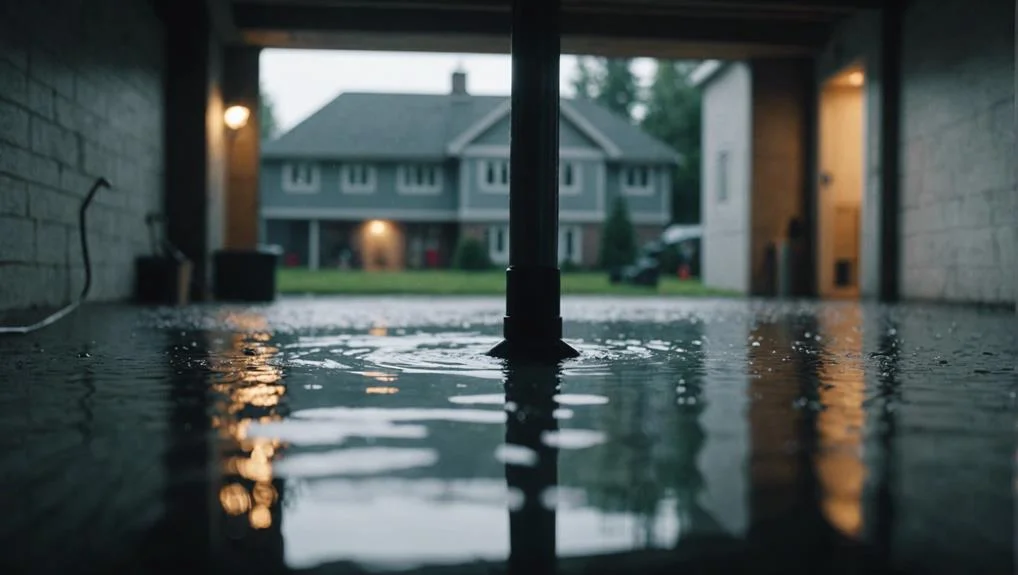
In your basement, a sump pump is basically a lifesaver, a device that removes water that accumulates in a water-collecting sump basin, commonly found in basements below the water table.
This device is especially vital in areas where the water table is above the foundation level, making it prone to flooding.
A sump pump, specifically a submersible sump pump, is designed to redirect water away from your home to a convenient drain off point.
When the water level inside the chamber reaches a certain level, the pump automatically kicks in, draining the water away from your basement.
This safeguard prevents water damage and flooding, giving you peace of mind and protecting your belongings.
How does a sump pump work?
Your sump pump system kicks into action when water starts accumulating in the sump chamber, triggering a float switch that activates the pump. As the water level rises, the float switch signals the primary sump pump to start pumping water out of the sump pit and away from your home.
There are two main types of sump pumps: submersible pumps, which are submerged in the sump pit, and pedestal sump pumps, which sit above the pit. Both types are designed to efficiently remove water and prevent flooding.
The sump pit collects water that drains from the surrounding area.
The float switch triggers the pump when the water level reaches a certain height.
The pump activates and starts pumping water out of the pit.
The water is redirected away from the home through internal pipes, preventing flooding and damage.
Do you need a sump pump?
Determine if you live in a high-risk flood area or have a history of water damage in your home to decide if investing in a sump pump is necessary for your peace of mind and property protection.
If you’re unsure, consider the consequences of a flooded basement: water damage, ruined possessions, and a hefty repair bill.
A sump pump can be a lifesaver in such situations, providing a reliable safeguard against flooding and damage.
You may need a sump pump if you live in an area prone to heavy rainfall, have a history of water accumulation in your basement, or experience frequent power outages that can disrupt your home’s drainage system.
Additionally, if you’ve noticed water seepage or dampness in your basement, a sump pump can help alleviate these issues.
Where does a sump pump discharge?
After collecting and pumping out water from your basement, a sump pump discharges it to a suitable location away from your home’s foundation. This ensures that the water doesn’t flow back into your basement, causing further damage. The discharge location is typically a storm drain, sewer, or a natural watercourse, such as a creek or pond.
When it comes to discharging water, it’s vital to take into account the following:
- Drainage regulations: Check with your local authorities to confirm you comply with drainage regulations and avoid fines.
- Water flow: Verify the discharge location can handle the water flow from your sump pump to prevent backups and flooding.
- Distance from foundation: Discharge the water at least 10-15 feet away from your home’s foundation to prevent water from seeping back into your basement.
- Environmental impact: Be mindful of the environmental impact of discharging water into natural watercourses, and contemplate using a sedimentation tank or oil interceptor if necessary.
What are the types of sump pumps
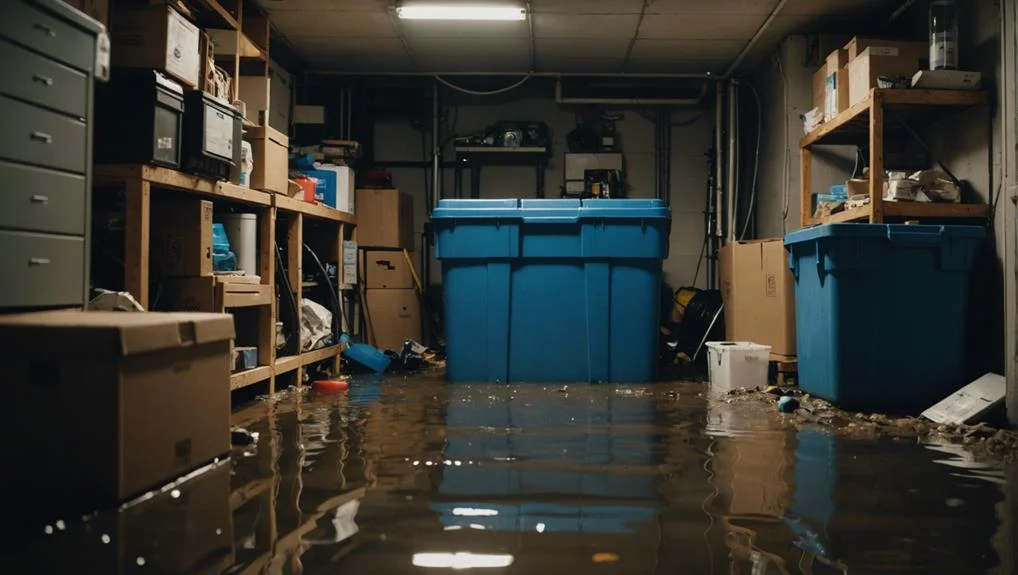
There are two main types of sump pumps submersible and pedestal pumps, which differ in design and functionality, as well as manual or automatic pumps that vary in operation.
Additionally, you’ll need to ponder factors like power, head pressure, and backup and alarm systems to guarantee you choose the right pump for your unique situation.
Submersible and Pedestal
When it comes to choosing the right sump pump for your home, you’ll likely encounter two primary types: submersible and pedestal pumps, each with its unique characteristics and benefits. Understanding the differences between these two types is crucial to making an informed decision.
Submersible pumps are designed to be submerged in water and are typically more powerful and efficient. They work by pumping water out of the sump basin and into the discharge pipe.
On the other hand, pedestal pumps sit above the sump basin and use a pipe to draw water from the basin.
Submersible pumps are more powerful and efficient, but may be noisier and require more maintenance.
Pedestal pumps are generally quieter and easier to maintain, but may be less powerful and more prone to clogging.
Sump pump work is affected by the type of pump you choose, with submersible pumps handling heavier water flows and pedestal pumps better suited for smaller amounts of water.
Pedestal sump and pedestal pump combinations are often used in smaller spaces or where a quieter operation is desired.
Manual or Automatic Pump
You have two primary options when it comes to choosing a sump pump: manual or automatic, each with its unique benefits and drawbacks that can substantially impact your home’s protection against flooding.
A manual pump requires you to physically switch it on and off, which requires you to be there and will lead to delays in responding to flooding.
An automatic pump is equipped with a sensor (float switch) that detects water levels and automatically activates the pump when needed.
When selecting between manual and automatic pumps, consider your specific needs and priorities.
If you’re looking for a more affordable option and don’t mind taking a more hands-on approach, a manual pump might be the way to go.
However, if you prioritise convenience and want a more reliable solution, an automatic pump could be the better choice.
Either way, it’s essential to choose a pump that suits your specific needs and provides the necessary protection for your home.
The amount of power
Selecting the right power for your sump pump is essential, since it directly affects the pump’s ability to handle water flow and how far it can pump it to prevent flooding.
When choosing a primary pump, you’ll encounter two main types: submersible pumps and pedestal pumps.
Submersible pumps: More visually appealing, but can be more expensive and tricky to repair.
Pedestal pumps: Often more economical, but may not last as long as submersible pumps. Can be noisy and prone to overheating.
Power balance: Verify that the pump’s power rating matches your basement’s flooding risk and water table level and the distance you have to to handle water flow effectively.
Quality matters: A good quality sump pump can run for an average of 20-24 hours straight, while a low-quality pump may only last 6-18 hours in a 24 hour period, depending on the power and usage.
Head Pressure
Your sump pump‘s head pressure is just as important as its power, as it determines how high the pump can push water up and away from your basement.
Head pressure refers to the maximum height that your pump can push water, typically ranging from 5 to 20 metres.
The type of sump pump and its power rating substantially affect the head pressure. For instance, a 0.25Kw sump pump typically has a head pressure of around 7.5 metres, while a 1.1Kw pump can handle up to 18 metres.
Additionally, the head pressure depends on the diameter and length of the discharge pipe, as well as the number of elbows and fittings, which can reduce the pump’s overall performance.
When selecting a sump pump, it’s essential to take into account the specific head pressure requirements of your basement, bearing in mind factors such as the water table, soil type, and drainage system.
Back up and Alarm Systems
In addition to a reliable sump pump, a backup system and alarm can provide an added layer of protection against basement flooding and water damage. You never know when a power outage might strike, leaving your primary pump useless. That’s where a backup sump pump comes in.
A battery backup system guarantees your pump keeps running during power outages, giving you peace of mind.
A high-level water alarm can alert you to rising water levels or pump failure, allowing you to take action before it’s too late.
Some backup pumps can run for up to 24 hours on a single battery charge, providing extended protection during prolonged power outages.
A well-maintained alarm system can prevent basement flooding and damage by alerting you to potential issues before they become major problems.
What is the best sump pump for my home?
When determining the best sump pump for your home, you’ll want to evaluate a combination of key factors, including power, head pressure, and type of pump, to guarantee you get a system that effectively protects your basement from water damage.
A primary sump pump with a power between 0.25kW and 0.25kW is a good starting point.
The Oreal CK range offers a good balance between value for money and features
You’ll also need to assess the head pressure, which should be able to pump water to the desired height.
Additionally, you’ll need to decide between a pedestal or submersible pump, with submersible pumps being quieter and more visually appealing, but also more expensive and tricky to repair.
Think about a backup sump pump and an alarm system to safeguard your basement even during power failures.
The size of your basement will also play a role in determining the size of the sump pump you need, with larger basements requiring more powerful pumps.
If you are looking for a small Sump pump our smallest sump pumps are listed below, the Pentair Flotec Compac is our overall smallest solution:
-
%27%20fill-opacity%3D%27.5%27%3E%3Cellipse%20fill%3D%22%23272725%22%20fill-opacity%3D%22.5%22%20rx%3D%221%22%20ry%3D%221%22%20transform%3D%22rotate(-5.6%201625.4%20-1372.3)%20scale(52.64483%20121.72137)%22%2F%3E%3Cellipse%20fill%3D%22%23fff%22%20fill-opacity%3D%22.5%22%20rx%3D%221%22%20ry%3D%221%22%20transform%3D%22matrix(-13.96388%20-298.50169%2052.69032%20-2.46485%20262%20127.9)%22%2F%3E%3Cellipse%20fill%3D%22%23fff%22%20fill-opacity%3D%22.5%22%20rx%3D%221%22%20ry%3D%221%22%20transform%3D%22matrix(-9.00505%20298.69241%20-42.15143%20-1.2708%2034.6%20121.9)%22%2F%3E%3Cellipse%20fill%3D%22%23454642%22%20fill-opacity%3D%22.5%22%20rx%3D%221%22%20ry%3D%221%22%20transform%3D%22matrix(28.07716%20-1.9693%206.02718%2085.93193%20141.5%20149)%22%2F%3E%3C%2Fg%3E%3C%2Fsvg%3E) Koshin Ponstar PX 55011 110v Automatic Submersible Pump£349.15 +VAT
Koshin Ponstar PX 55011 110v Automatic Submersible Pump£349.15 +VAT -
%27%20fill-opacity%3D%27.5%27%3E%3Cellipse%20fill%3D%22%23272725%22%20fill-opacity%3D%22.5%22%20rx%3D%221%22%20ry%3D%221%22%20transform%3D%22rotate(-5.6%201625.4%20-1372.3)%20scale(52.64483%20121.72137)%22%2F%3E%3Cellipse%20fill%3D%22%23fff%22%20fill-opacity%3D%22.5%22%20rx%3D%221%22%20ry%3D%221%22%20transform%3D%22matrix(-13.96388%20-298.50169%2052.69032%20-2.46485%20262%20127.9)%22%2F%3E%3Cellipse%20fill%3D%22%23fff%22%20fill-opacity%3D%22.5%22%20rx%3D%221%22%20ry%3D%221%22%20transform%3D%22matrix(-9.00505%20298.69241%20-42.15143%20-1.2708%2034.6%20121.9)%22%2F%3E%3Cellipse%20fill%3D%22%23454642%22%20fill-opacity%3D%22.5%22%20rx%3D%221%22%20ry%3D%221%22%20transform%3D%22matrix(28.07716%20-1.9693%206.02718%2085.93193%20141.5%20149)%22%2F%3E%3C%2Fg%3E%3C%2Fsvg%3E) Koshin Ponstar PX 55011 110v Manual Submersible Pump£321.55 +VAT
Koshin Ponstar PX 55011 110v Manual Submersible Pump£321.55 +VAT -
%27%20fill-opacity%3D%27.5%27%3E%3Cellipse%20fill%3D%22%23272725%22%20fill-opacity%3D%22.5%22%20rx%3D%221%22%20ry%3D%221%22%20transform%3D%22rotate(-5.6%201625.4%20-1372.3)%20scale(52.64483%20121.72137)%22%2F%3E%3Cellipse%20fill%3D%22%23fff%22%20fill-opacity%3D%22.5%22%20rx%3D%221%22%20ry%3D%221%22%20transform%3D%22matrix(-13.96388%20-298.50169%2052.69032%20-2.46485%20262%20127.9)%22%2F%3E%3Cellipse%20fill%3D%22%23fff%22%20fill-opacity%3D%22.5%22%20rx%3D%221%22%20ry%3D%221%22%20transform%3D%22matrix(-9.00505%20298.69241%20-42.15143%20-1.2708%2034.6%20121.9)%22%2F%3E%3Cellipse%20fill%3D%22%23454642%22%20fill-opacity%3D%22.5%22%20rx%3D%221%22%20ry%3D%221%22%20transform%3D%22matrix(28.07716%20-1.9693%206.02718%2085.93193%20141.5%20149)%22%2F%3E%3C%2Fg%3E%3C%2Fsvg%3E) Koshin Ponstar PX 55022 230v Automatic Submersible Pump£349.15 +VAT
Koshin Ponstar PX 55022 230v Automatic Submersible Pump£349.15 +VAT -
%27%20fill-opacity%3D%27.5%27%3E%3Cellipse%20fill%3D%22%23272725%22%20fill-opacity%3D%22.5%22%20rx%3D%221%22%20ry%3D%221%22%20transform%3D%22rotate(-5.6%201625.4%20-1372.3)%20scale(52.64483%20121.72137)%22%2F%3E%3Cellipse%20fill%3D%22%23fff%22%20fill-opacity%3D%22.5%22%20rx%3D%221%22%20ry%3D%221%22%20transform%3D%22matrix(-13.96388%20-298.50169%2052.69032%20-2.46485%20262%20127.9)%22%2F%3E%3Cellipse%20fill%3D%22%23fff%22%20fill-opacity%3D%22.5%22%20rx%3D%221%22%20ry%3D%221%22%20transform%3D%22matrix(-9.00505%20298.69241%20-42.15143%20-1.2708%2034.6%20121.9)%22%2F%3E%3Cellipse%20fill%3D%22%23454642%22%20fill-opacity%3D%22.5%22%20rx%3D%221%22%20ry%3D%221%22%20transform%3D%22matrix(28.07716%20-1.9693%206.02718%2085.93193%20141.5%20149)%22%2F%3E%3C%2Fg%3E%3C%2Fsvg%3E) Koshin Ponstar PX 55022 230v Manual Submersible Pump£321.55 +VAT
Koshin Ponstar PX 55022 230v Manual Submersible Pump£321.55 +VAT -
 Pentair Flotec Compac 200 (DPC) 230v Submersible Pump£243.58 +VAT
Pentair Flotec Compac 200 (DPC) 230v Submersible Pump£243.58 +VAT -
 Pentair Flotec Compac 150 110v Submersible Pump£214.60 +VAT
Pentair Flotec Compac 150 110v Submersible Pump£214.60 +VAT -
 Pentair Flotec Compac 150 230v Submersible Pump£214.60 +VAT
Pentair Flotec Compac 150 230v Submersible Pump£214.60 +VAT -
%27%20fill-opacity%3D%27.5%27%3E%3Cellipse%20fill%3D%22%23575757%22%20fill-opacity%3D%22.5%22%20rx%3D%221%22%20ry%3D%221%22%20transform%3D%22matrix(-8.17173%20-72.82652%2054.25951%20-6.08836%20144.6%20160.6)%22%2F%3E%3Cellipse%20fill%3D%22%23585858%22%20fill-opacity%3D%22.5%22%20rx%3D%221%22%20ry%3D%221%22%20transform%3D%22matrix(-3.63357%20-42.38378%2030.71439%20-2.63315%20146%20162)%22%2F%3E%3Cellipse%20fill%3D%22%23fff%22%20fill-opacity%3D%22.5%22%20rx%3D%221%22%20ry%3D%221%22%20transform%3D%22rotate(80.1%2044.3%20233.8)%20scale(298.82813%2083.61165)%22%2F%3E%3Cellipse%20fill%3D%22%23fff%22%20fill-opacity%3D%22.5%22%20rx%3D%221%22%20ry%3D%221%22%20transform%3D%22matrix(8.617%20269.45255%20-56.88968%201.81931%2047.6%20156.6)%22%2F%3E%3C%2Fg%3E%3C%2Fsvg%3E) Pentair Flotec Compac 150 & 200 Submersible (Sump) PumpsFrom £214.60
Pentair Flotec Compac 150 & 200 Submersible (Sump) PumpsFrom £214.60 -
%22%20transform%3D%22translate(.6%20.6)%20scale(1.17188)%22%20fill-opacity%3D%22.5%22%3E%3Cellipse%20fill%3D%22%2374727c%22%20rx%3D%221%22%20ry%3D%221%22%20transform%3D%22matrix(-.7043%2041.44032%20-94.80485%20-1.61125%20136%2076)%22%2F%3E%3Cellipse%20fill%3D%22%23fff%22%20cx%3D%2211%22%20cy%3D%22208%22%20rx%3D%2223%22%20ry%3D%22236%22%2F%3E%3Cellipse%20fill%3D%22%23b2c458%22%20cx%3D%22125%22%20cy%3D%22188%22%20rx%3D%22100%22%20ry%3D%2227%22%2F%3E%3Cellipse%20fill%3D%22%23fffdff%22%20rx%3D%221%22%20ry%3D%221%22%20transform%3D%22rotate(1.1%2095.5%2010120.4)%20scale(255%2027.86183)%22%2F%3E%3C%2Fg%3E%3C%2Fsvg%3E) JS RS-100 110v 1″ Light Duty Drainage Pump£115.24 +VAT
JS RS-100 110v 1″ Light Duty Drainage Pump£115.24 +VAT
How long do sump pumps last?
With the right sump pump chosen for your home, the next question is how long you can expect it to last, and the answer depends on factors like maintenance and usage.
A well-maintained sump pump can last up to 10 years or more, but neglecting regular service can drastically reduce its lifespan.
To guarantee your pump runs smoothly, it’s essential to perform regular maintenance.
Regular servicing can help extend the life of your sump pump.
Pumps used frequently may require servicing every 6 months.
Maintenance every 12 months is recommended to keep your pump in good working condition.
How to choose a sump pump
When selecting a sump pump for your basement or crawl space, consider these key factors:
Pump type:
- Submersible: Installed directly in the sump pit
- Pedestal: Motor sits above the pit, less expensive but noisier
Power source:
- Electric: Most common, requires nearby outlet
- Battery backup: Provides protection during power outages
Power:
- 250 W: Suitable for most residential applications
- 500 W: For higher water flow or deeper basements
- 750 to 1000 W: For commercial or large residential properties
Flow rate:
- Measured in gallons per hour (LPM)
- Choose based on your home’s water table and drainage needs
Switch type:
- Float switch: Activates when water reaches a certain level
- Electronic switch: More precise, less prone to mechanical failure
Materials:
- Cast iron: Durable, dissipates heat well
- Thermoplastic: Lighter, corrosion-resistant
Pit size:
- Ensure the pump fits your existing sump pit
- Consider a larger pit for increased water capacity
Alarm system:
- Alerts you to pump failure or high water levels
Warranty:
- Look for pumps with longer warranties for peace of mind
Brand reputation:
- Research customer reviews and expert recommendations
Additional features:
- Dual pumps for redundancy
- Wi-Fi connectivity for remote monitoring
By carefully evaluating these factors, you can select a sump pump that best meets your home’s specific needs and provides reliable protection against water damage.
Alternatives to Sump Pumps
As you consider alternatives to sump pumps, you’ll want to explore options that redirect water away from your home.
French drains, which involve installing a trench filled with gravel and a perforated pipe, are a popular choice.
You’ll also want to look into waterproofing compounds, gutter maintenance, and sloping the ground to prevent water accumulation.
French drains
If you’re looking for an alternative to sump pumps, consider installing a French drain, a cost-effective and environmentally friendly solution that redirects water away from your home. This innovative system is designed to prevent water accumulation in your basement or foundation, reducing the risk of flooding and damage.
French drains don’t require electricity, making them a reliable solution for areas prone to power outages. They are a budget-friendly alternative to sump pumps, with locally sourced materials and minimal installation costs. French drains redirect water naturally without relying on electricity or chemical treatments.
French drains can be installed internally or externally, redirecting water from specific areas, such as a basement corner or a low-lying area of a yard.
Waterproofing compound
You can also consider applying waterproofing compounds to your basement walls and floors as an alternative to sump pumps, especially in areas with low water tables.
This solution is particularly effective in preventing water infiltration and reducing the need for sump pumps.
Epoxy-based waterproofing compounds are highly effective in preventing water seepage and can be used in conjunction with drainage systems to provide added protection against flooding.
Polyurethane-based compounds are flexible and can stretch to accommodate minor foundation movements, making them a popular choice for sealing cracks and joints in basement walls and floors.
Acrylic-based compounds are water-based and non-toxic, making them a safe and environmentally friendly alternative to sump pumps in residential areas.
When applied correctly, waterproofing compounds can provide a permanent solution to water infiltration and flooding, eliminating the need for sump pumps and reducing maintenance costs over time.
Gutter maintenance
Proper gutter maintenance plays a crucial role in preventing water accumulation around your home’s foundation, thereby reducing the need for a sump pump. By keeping your gutters clean and clear, you can guarantee that water flows away from your home, reducing the risk of water damage and basement flooding.
Regular gutter cleaning can help prevent water accumulation around the foundation of your house, reducing the need for a sump pump.
Installing gutter guards can help reduce debris accumulation and confirm that gutters function properly, reducing the risk of water damage and the need for a sump pump.
Ensuring that downspouts extend at least 1-2 metres away from the foundation can help direct water away from your home, reducing the risk of water accumulation and the need for a sump pump.
Regular inspections and maintenance of gutters and downspouts can help identify and address issues before they cause water damage, making them a crucial alternative to relying solely on a sump pump.
Sloping the ground
By carefully sloping the ground around your house, you can redirect water away from the foundation, reducing the need for a sump pump and the risk of water damage.
This approach is a simple yet effective alternative to sump pumps. To achieve the desired effect, aim for a 1-2% grade on the ground surrounding your house.
This slight incline will facilitate that water flows away from your foundation, reducing the likelihood of water accumulation in your basement. By redirecting water away from your house, you’ll minimise the risk of water damage and create a safer, drier living space.
By incorporating sloping into your landscaping, you can enjoy a more secure and peaceful living environment. Plus, this approach can be used in conjunction with other alternatives, such as French drains, swales, and rain gardens, to create an integrated water management system.
Frequently Asked Questions
What are Sump Pumps used for?
Sump pumps are primarily used to prevent flooding in basements and crawl spaces. They are installed in a pit, called a sump, at the lowest point of these areas. When groundwater or excess moisture accumulates, the pump automatically activates to remove the water and discharge it away from the building’s foundation. This helps protect homes from water damage, mould growth, and structural issues caused by moisture infiltration. Sump pumps are especially crucial in areas with high water tables, frequent rainfall, or prone to flooding.
Where Does a Sump Pump Pull Water From?
It collects water from the surrounding area, which drains into the sump chamber, the lowest point in your basement, keeping your home safe from water damage and flooding.
Where Should a Sump Pump Drain To?
You’ll want to direct your sump pump to drain to a safe distance from your home’s foundation, ideally 3-5 metres away, to prevent water from re-entering your basement or causing structural damage.
What Are the Different Types of Sump Pumps?
You’re wondering about the different types of sump pumps, right? Well, you’ve got submersible, pedestal, and battery-backup pumps to choose from, each with its own unique benefits and features to fit your specific needs and budget!
Conclusion
You now have a thorough understanding of sump pumps, their functions, and types.
By considering factors like discharge location, pump type, and maintenance needs, you can make an informed decision about the best sump pump for your home.
Remember to regularly inspect and maintain your pump to confirm it continues to protect your home from water damage.
With the right sump pump and proper care, you can enjoy peace of mind and a dry basement.
If you have any questions get in touch with our team today.

